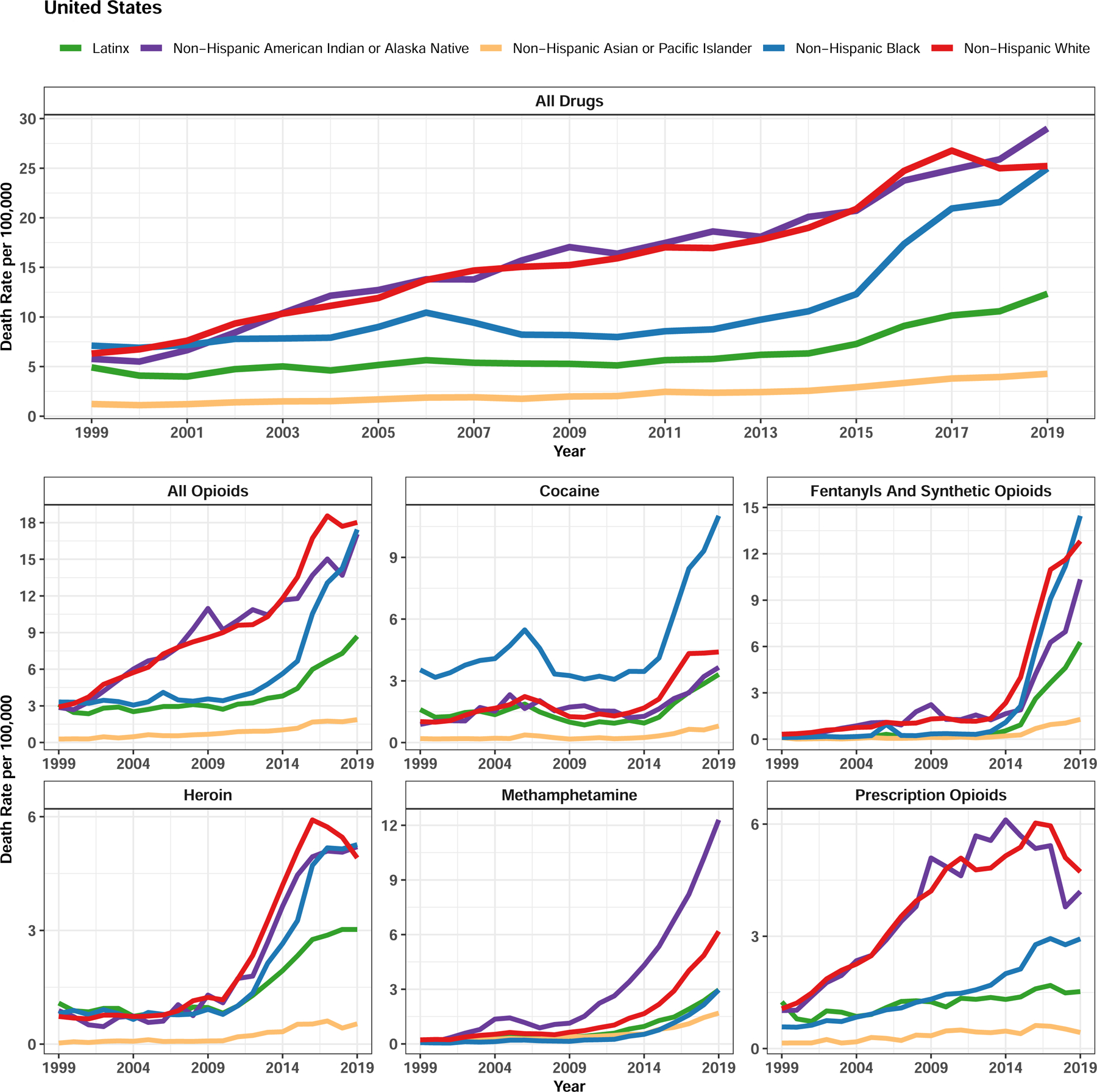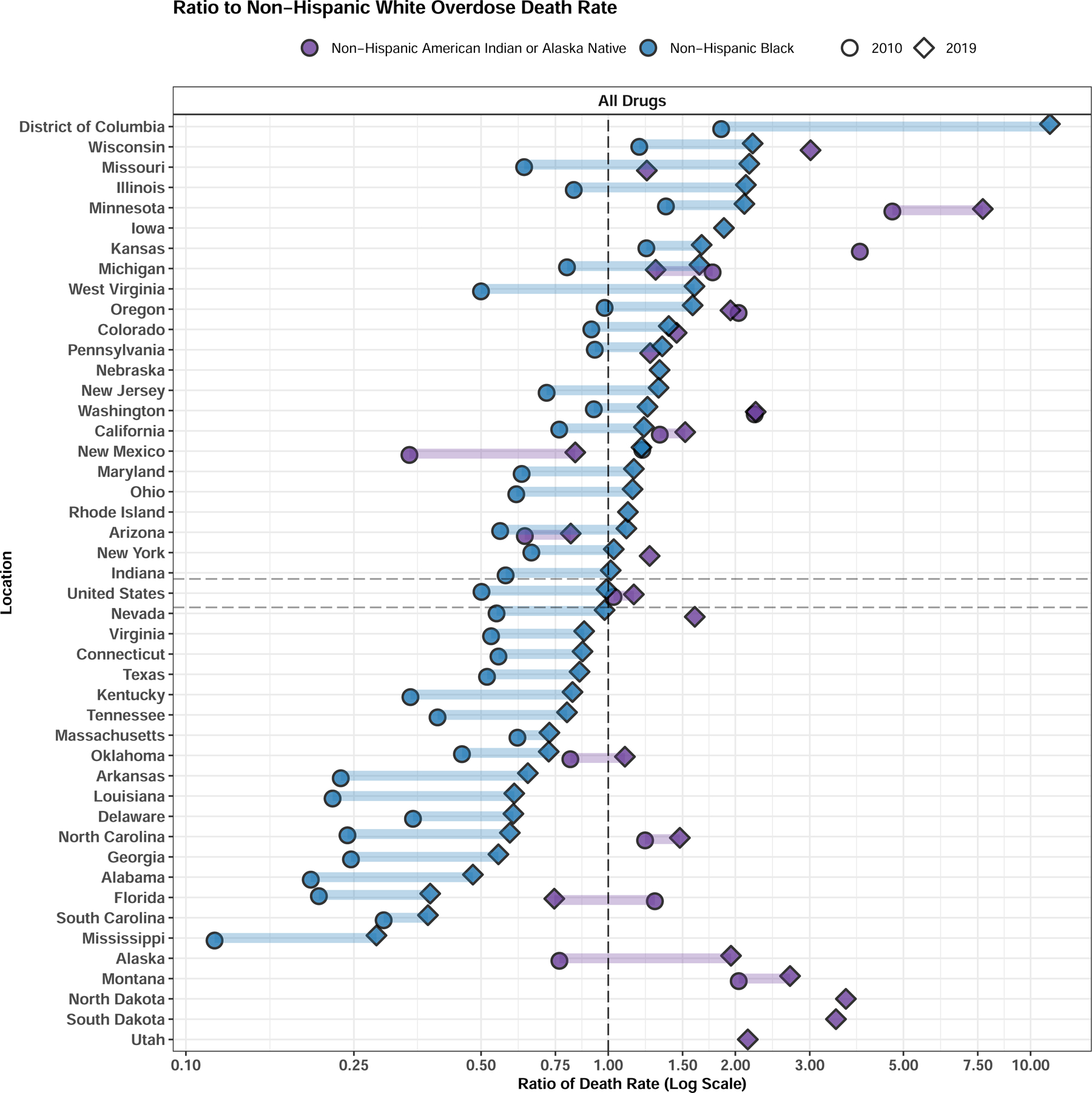As the four-decade long overdose crisis enters its ‘fourth wave’— characterized by polysubstance use of potent, illicitly-manufactured, synthetic opioids, psychostimulants, and other drugs1–4—renewed attention is warranted to trends stratified by race and ethnicity. Although in recent years the drug crisis has been largely portrayed as a “White problem” this narrative has never accounted for evident racial disparities5,6. New data paint a stark picture of worsening burden of overdose on minoritized communities7.
Using records from the National Vital Statistics System we examined drug-related overdose mortality per 100,000 people separately by race/ethnicity, state, and type of drugs involved from 1999 to 2019 (see supplementary methods for more details). For state-years where comparisons could be made, the rate for each racial/ethnic group was compared to that of Non-Hispanic White individuals as a ratio.
Overdose mortality per capita among Non-Hispanic Black individuals more than tripled between 2010 and 2019, compared to a 58% increase among Non-Hispanic Whites during the same period (Figure 1). In 2010, Non-Hispanic Black individuals had an overdose mortality rate that was 0.50 times that of Non-Hispanic Whites. Yet by 2019 the ratio had surged to 0.99 (Figure 2). In 2010, the Black-White overdose mortality ratio was above 1.0 in only n=5 (13.5%) of 37 states with sufficient population size for comparisons. However, by 2019, Black mortality exceeded that of White individuals in 23 (57.5%) of the 40 states covered (Figure 2). These shifts were largely driven by elevated rates of overdose involving fentanyl and its analogues (with a Black-White ratio in 2019 of 1.13), heroin (1.07), and cocaine (2.50).
Figure 1.

Drug-related overdose mortality per 100,000 by race/ethnicity and type of drugs involved, 1999–2019. Both numerator and denominator are specific to each racial/ethnic group.
Figure 2.

Ratio of total drug-related overdose mortality per 100,000 for Non-Hispanic Black individuals (shown in blue) and Non-Hispanic American Indian or Alaska Native individuals (shown in purple) relative to Non-Hispanic White individuals. Results shown for states with sufficient population to allow for at least one comparison in 2010 (shown as circle) or 2019 (shown as diamond).
Overdose rates among Non-Hispanic American Indian or Alaska Native (AI/AN) individuals rose from 1.03 times that of White individuals in 2010, to 1.15 in 2019. Increases in methamphetamine-related overdose represented the largest component of the increase, rising over 8-fold between 2010 and 2019 to reach 12.30 per 100,000 people. In 2019, the AI/AN-White overdose mortality ratio was above 1.0 in n=18 (85.7%) of 21 states where comparisons could be made.
Distinct age and sex patterns can be observed by race/ethnicity (supplemental Figure 1). Among males, the highest observed race/ethnicity- and age-specific total overdose death rates were observed among Non-Hispanic Black men 55–59 years of age. Their rate of 89.5 deaths per 100,000, represented nearly double the rate of Non-Hispanic White individuals of the same age. Conversely, the highest total overdose death rates among Non-Hispanic White men were observed in the 35–39 years age category, with 74.3 deaths per 100,000. This represented 23.5% higher than Non-Hispanic Black Men of the same age. The Black-White overdose death gap is therefore distinct for younger and older men. Yet the disparities between older Black and White men are the largest magnitude. This drives an average trend of higher overdose mortality for Black men relative to their White counterparts, in both age-standardized and population weighted terms. Among women, the highest total overdose rates were observed among AI/AN women 35–39 years of age, with 55.1 deaths per 100,000. This represented a death rate 56.5% higher than that of Non-Hispanic White women of the same age.
The data presented here should be interpreted in the context of limitations affecting overdose surveillance in the United States. Quality of reporting is known to vary between states, and race/ethnicity may be incorrectly assigned for some deaths, especially among American Indian and Alaska Native populations8. Although clear trends can be observed at the national level, caution is warranted in interpreting specific state and race/ethnicity-specific findings, given potential for variability in quality and reporting standards.
These trends are particularly concerning given that the COVID-19 pandemic has drastically exacerbated overdose mortality in the United States9. Recent surges are likely to widen racial/ethnic overdose disparities5,7,10. Troublingly, provisional CDC overdose mortality reports and modelling efforts documenting recent trends contain no information about race or ethnicity11,12. This impedes timely surveillance of disparities in overdose and delays efforts to address them.
As the nation grapples with the fallout from the COVID-19 pandemic, racial disparities have gained increased research and policy attention13,14. Similarly, rapidly-surging overdose burden among Black and AI/AN communities must be understood as a symptom of structural racism13. This includes discriminatory criminal laws and their inequitable enforcement by police, as well as systematic barriers in access to healthcare. This has resulted in a landscape of decreased substance use treatment initiation and engagement15, and poor access to addiction specialists, especially from underrepresented minority backgrounds16. Additional upstream drivers of overdose include gaps in education, employment, and access to medical care. The pandemic has deepened many of these inequalities, as communities of color have been disproportionately affected by disruptions to schooling and employment and healthcare, in particular17,18. These shifts necessitate centering an anti-racist approach in the national response to the growing overdose crisis, during the pandemic and post-pandemic recovery period.
Supplementary Material
Contributor Information
Joseph Friedman, Medical Scientist Training Program, University of California, Los Angeles.
Leo Beletsky, Northeastern University, School of Law and Bouvé College of Health Sciences.
Ayana Jordan, Yale University School of Medicine.
References
- 1.Ciccarone D. The rise of illicit fentanyls, stimulants and the fourth wave of the opioid overdose crisis. Curr Opin Psychiatry 2021;34(4):344–50. [DOI] [PMC free article] [PubMed] [Google Scholar]
- 2.Shover CL, Falasinnu TO, Dwyer CL, et al. Steep increases in fentanyl-related mortality west of the Mississippi River: Recent evidence from county and state surveillance. Drug Alcohol Depend 2020;216:108314. [DOI] [PMC free article] [PubMed] [Google Scholar]
- 3.Laing MK, Ti L, Marmel A, et al. An outbreak of novel psychoactive substance benzodiazepines in the unregulated drug supply: Preliminary results from a community drug checking program using point-of-care and confirmatory methods. Int J Drug Policy 2021;103169. [DOI] [PubMed]
- 4.Jalal H, Buchanich JM, Roberts MS, Balmert LC, Zhang K, Burke DS. Changing dynamics of the drug overdose epidemic in the United States from 1979 through 2016. Science 2018;361(6408):eaau1184. [DOI] [PMC free article] [PubMed] [Google Scholar]
- 5.Hansen H, Netherland J. Is the Prescription Opioid Epidemic a White Problem? Am J Public Health 2016;106(12):2127–9. [DOI] [PMC free article] [PubMed] [Google Scholar]
- 6.James K, Jordan A. The Opioid Crisis in Black Communities. J Law Med Ethics 2018;46(2):404–21. [DOI] [PubMed] [Google Scholar]
- 7.Friedman J, Mann NC, Hansen H, et al. Racial/Ethnic, Social, and Geographic Trends in Overdose-Associated Cardiac Arrests Observed by US Emergency Medical Services During the COVID-19 Pandemic. JAMA Psychiatry [Internet] 2021. [cited 2021 Jun 1];Available from: https://jamanetwork.com/journals/jamapsychiatry/fullarticle/2780427 [DOI] [PMC free article] [PubMed]
- 8.Jim MA, Arias E, Seneca DS, et al. Racial misclassification of American Indians and Alaska Natives by Indian Health Service Contract Health Service Delivery Area. Am J Public Health 2014;104 Suppl 3:S295–302. [DOI] [PMC free article] [PubMed] [Google Scholar]
- 9.Friedman J, Akre S. COVID-19 and the Drug Overdose Crisis: Uncovering the Deadliest Months in the United States, January–July 2020. Am J Public Health 2021;e1–8. [DOI] [PMC free article] [PubMed]
- 10.Khatri UG, Pizzicato LN, Viner K, et al. Racial/Ethnic Disparities in Unintentional Fatal and Nonfatal Emergency Medical Services–Attended Opioid Overdoses During the COVID-19 Pandemic in Philadelphia. JAMA Netw Open 2021;4(1):e2034878. [DOI] [PMC free article] [PubMed] [Google Scholar]
- 11.Products - Vital Statistics Rapid Release - Provisional Drug Overdose Data [Internet]. 2020. [cited 2020 Dec 25];Available from: https://www.cdc.gov/nchs/nvss/vsrr/drug-overdose-data.htm
- 12.Rossen LM, Hedegaard H, Ahmad FB. Early Provisional Estimates of Drug Overdose, Suicide, and Transportation-related Deaths: Nowcasting Methods to Account for Reporting Lags. :21. [Google Scholar]
- 13.Bailey ZD, Feldman JM, Bassett MT. How Structural Racism Works — Racist Policies as a Root Cause of U.S. Racial Health Inequities. N Engl J Med 2021;384(8):768–73. [DOI] [PMC free article] [PubMed] [Google Scholar]
- 14.Kalin NH, Binder E, Brady KT, et al. The American Journal of Psychiatry’s Commitment to Combat Racism, Social Injustice, and Health Care Inequities. Am J Psychiatry 2020;177(9):791–791. [DOI] [PubMed] [Google Scholar]
- 15.Lagisetty PA, Ross R, Bohnert A, Clay M, Maust DT. Buprenorphine Treatment Divide by Race/Ethnicity and Payment. JAMA Psychiatry 2019;76(9):979–81. [DOI] [PMC free article] [PubMed] [Google Scholar]
- 16.Jordan A, Jegede O. Building Outreach and Diversity in the Field of Addictions. Am J Addict 2020;29(5):413–7. [DOI] [PubMed] [Google Scholar]
- 17.Friedman J, York H, Mokdad AH, Gakidou E. U.S. Children “Learning Online” during COVID-19 without the Internet or a Computer: Visualizing the Gradient by Race/Ethnicity and Parental Educational Attainment. Socius 2021;7:2378023121992607. [DOI] [PMC free article] [PubMed] [Google Scholar]
- 18.Berkowitz SA, Basu S. Unemployment Insurance, Health-Related Social Needs, Health Care Access, and Mental Health During the COVID-19 Pandemic. JAMA Intern Med 2021;181(5):699. [DOI] [PMC free article] [PubMed] [Google Scholar]
Associated Data
This section collects any data citations, data availability statements, or supplementary materials included in this article.


